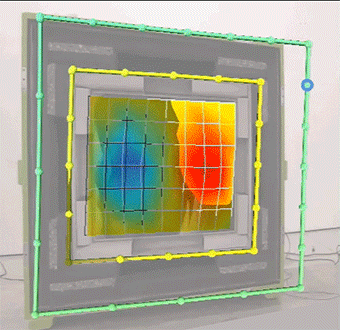Vibration during transit has been exposed as a serious threat to canvas paintings.
This site serves as a hub for sharing research, information and ideas related to this issue.
Vibration during transit has been exposed as a serious threat to canvas paintings.
This site serves as a hub for sharing research, information and ideas related to this issue.
Vibration during transit has been exposed as a serious threat to canvas paintings.
This site serves as a central hub for sharing research, information and ideas related to this issue.

Transit-related damage to canvas paintings is typically attributed to shocks, collision or impacts during a move. Unexpectedly, recent research utilizing modern sensing technologies has revealed vibration as the likely culprit for the harm that accumulates with travel.
This site is dedicated to helping concerned members of the art community better understand the nature of vibration damage that occurs during transit. The latest research and information related to this issue is posted below. The more we know about this problem, the faster solutions can be developed to better preserve the artwork we’ve been entrusted to protect.

Finite Element Modeling of Vibrations in Canvas Paintings

Damping Capacity of Backing Boards and Glazing

Vibration Damping Systems for Sculpture Pedestals

Damping Capacity of Painting Packing Systems

Bern University Fragile Artwork Conservation Project

GO Safe Alpha Case Testing Report

Sample Offline Article 1
Here's a brief description of the article and where you can find the article out in the real world.

Sample Offline Article 2
Here's a brief description of the article and where you can find the article out in the real world.

Sample Offline Article 3
Here's a brief description of the article and where you can find the article out in the real world.

Sample Offline Article 4
Here's a brief description of the article and where you can find the article out in the real world.

Sample Offline Article
Here is a short description of this particular article

What’s the difference between shock and vibration during fine art shipping?
Answer
Most fine art shipments are well protected from shocks. Air-ride truck suspensions and foam packing do an admirable job soaking up odd bumps and jiggles encountered while loading and traveling. Loads are carefully strapped and secured so that collisions inside the truck are consistently prevented.
The vibration problem, however, starts with the construction of the painting itself: a canvas stretched across a framework is constructed just like a drumhead. The painting therefore naturally vibrates when it comes in contact with input vibrations at a frequency range of about 10 – 50 hertz (or vibrations per second). This means that any low-frequency vibrations transmitted in the shipping or handling process (truck tires on road surfaces, aircraft takeoffs and landings, etc.) is transmitted through wood crates and foam packing, causing the canvas inside the crate to vibrate, stressing and breaking the bonds that make up the paint layers on the canvas.

How harmful is vibration to artwork?
Answer
Vibration-induced damage to canvas paintings follows a fatigue model, starting out as invisible micro-cracks and separations inside the layers of primer and paint. Over time and with more travel, these micro-cracks accumulate until they link together and visibly break through the paint layers. Cracking, cleaving, and flaking paints then become noticeable and must be addressed through conservation. This process is destructive and costly to repair. And no one prefers a well-repaired collection to a well-preserved collection.

Does this happen with all paintings?
Answer
We’ve tested dozens of stretched canvas paintings in the collection of the Georgia O’Keeffe Museum. The frequency range where the canvas begins to vibrate varies somewhat based on the size of the painting, its construction, and its condition but as long as you are working with a canvas stretched over a strainer or stretcher frame, physics dictates that it will vibrate when encountering certain frequencies. And low-frequency vibration is present is all forms of transportation: trucks, vans, air freighters, etc.

We pack paintings inside a travel box that sits inside a foam-cushioned, reinforced wood crate (industry best practice). Are you saying that vibration gets through all these layers to the painting?
Answer
Yes. It may be counterintuitive, but the vibrations that result in the greatest movement of canvas paintings definitely penetrate all of these layers. We conducted experiments using laser Doppler vibrometry to measure the movement of real paintings while traveling inside both a crate and a travel box. The image you see below is the canvas moving due to input from typical travel-induced vibration:


Why not use different kinds of foam packing to cut down or eliminate vibration?
Answer
Our testing, as well as experiments at the University of the Arts, Bern, Switzerland, demonstrate that all commonly used foam products transmit low frequency vibration. In fact, it’s much worse than that – both our tests and the tests in Switzerland demonstrate that commonly used shipping materials (wood crates and foam cushions) actually AMPLIFY travel-related vibration in the range of 10 Hz to 100 Hz. This is because these materials compress and expand “in sympathy” with the frequencies of the vibrating painting. Using these materials creates an in-phase, additive interference that amplifies the movement of the vibrations transmitted by the truck and the wooden outer crate.

How quickly does vibration-induced damage add up for a particular work of art?
Answer
Our studies of previously undamaged, 20th century oil paintings on canvas suggest that cracks and other forms of visible damage can begin to appear after only 20,000 road miles or as little as twelve, 24-hour transport trips. In today’s world, that’s roughly the equivalent of three, 3-venue touring exhibitions.

What is GOSafe?
Answer
GO Safe Technologies is a Georgia O’Keeffe Museum Innovations company dedicated to researching and identifying the ways in which artwork is damaged during transit. After finding fresh vibration damage in canvas paintings with cumulative lifetime road travel of only 20,000 miles, we dedicated ourselves to not only conducting our own extensive, highly specialized research, but also compiling and sharing all related research on this site as an industry resource. GO Safe is also working to develop a revolutionary solution to the vibration problem – a highly advanced shipping container designed to keep both O’Keeffe’s paintings and the art collections of the world safer during transport.
If you would like to share your own story related to artwork shipping damage, or if you have questions, related research or other information, feel free to submit it here. Or email us at info@gosafetechnologies.com.